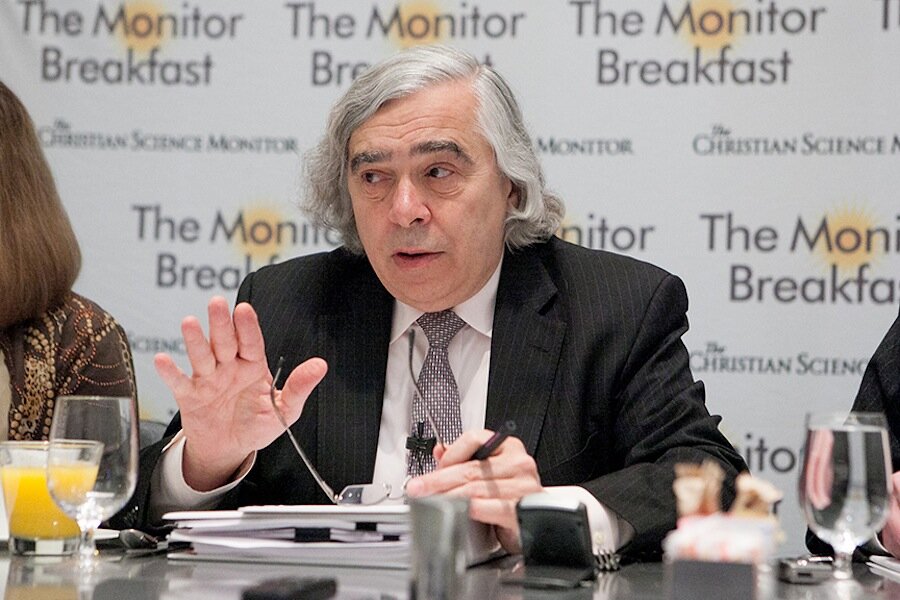Climate change, cyberattacks are growing threats to grid, says US energy chief
Loading...
| Washington
US energy infrastructure is vast, aging, and in need of an overhaul, Energy Secretary Ernest Moniz says, and the biggest challenges are the most unpredictable: climate change and cyberattacks.
Staggering in size, the US energy system includes 2.6 million miles of pipeline and 6.3 million miles of electrical distribution lines. There are 414 natural gas storage facilities and 330 ports handling crude and petroleum products, plus 140,000 miles of railway carrying crude and more from well to refinery – and that’s only a small sample of the transmission, distribution, and storage systems that power the US.
But all of that infrastructure is vulnerable to growing threats, Sec. Moniz said Monday at a Monitor-hosted breakfast for reporters in Washington.
“I’m not going to single out one [threat] because we’ve got to address them all,” Moniz said. But looking ahead, he added, “I think the two that almost certainly will increase in risk level are cyber and extreme weather” made worse by climate change.
Last week, Moniz rolled out his department’s Quadrennial Energy Review (QER), identifying weaknesses in US energy infrastructure – from inadequate natural gas distribution pipelines to an outdated electric systems.
The electric grid, the report found, is especially vulnerable.
“Threats to the grid – ranging from geomagnetic storms that can knock out crucial transformers; to terrorist attacks on transmission lines and substations; to more flooding, faster sea-level rise, and increasingly powerful storms from global climate change – have been growing even as society’s dependence on the grid has increased,” according to the report.
Among its recommendations for modernizing US energy infrastructure – most of which would require appropriations from the GOP-controlled Congress – the QER requested $3.5 billion to update the electric grid, $2.5 billion to improve distribution of natural gas, and at least $1.5 billion to shore up the Strategic Petroleum Reserve, an emergency stockpile of oil.
The question is whether the Obama administration and Republicans in Congress can agree on which energy projects to pursue and how to fund them.
Some observers are hopeful that compromise is possible, particularly in light of bipartisan deals in recent weeks that brought a Medicare “doc fix,” the confirmation of Attorney General Loretta Lynch, and an anti-human-trafficking bill across the finish line.
“There is momentum and serious commitment to get some energy legislation out of Congress, and you’re hearing it from all the leadership,” says Margot Anderson, executive director of the energy project at the Bipartisan Policy Center, a Washington think tank, in an interview Friday. “I think the QER can provide some new ideas, and can be incorporated into what leadership is already talking about.”
The GOP response to the Obama administration’s QER last week suggested compromise between Republicans on Capitol Hill and the Democratic administration was possible – at least on some issues.
“While we share our differences with this administration regarding energy policy, when it comes to the transmission, storage, and distribution of our resources, we can all agree that targeted changes to our laws and policies are necessary,” Rep. Fred Upton (R) of Michigan and Rep. Ed Whitfield (R) of Kentucky, two top energy lawmakers, said last week in a joint statement.
What’s unclear is how the Republican caucus will react to energy spending related to climate change. Many Republicans in Congress have rejected the idea that humans are causing climate change, or that the government should take regulatory action to reduce emissions.
Moniz urged immediate action on climate change at Monday’s breakfast, and noted that the QER is a part of President Obama’s Climate Action Plan.
“It’s time to stop debating what’s not debatable,” he said of global warming, referencing the broad scientific consensus that climate change is happening and is human-generated.
Climate change is a threat to energy infrastructure because planetary warming exacerbates high-intensity storms, makes water scarce, and alters weather patterns – all of which can put unexpected strain on the US grid and can stress other critical infrastructure. Moniz said he was hopeful that efforts to curb climate change would stall warming, diminishing the threat extreme weather poses in the future.
At the same time, though, the grid is under attack from cyber threats both domestically and around the world.
Moniz emphasized that the energy sector needs to adapt to ever-changing cyber threats, so that the industry can “stay ahead of the bad guys.”
As the Monitor reported in December, critical infrastructure in the US is already under attack from hackers, and the grid would be a prime target in cyberwar.
“The electric industry, in reality, has done an inadequate job of securing the electric system,” Joe Weiss, a leading expert on electric grid security, told the Monitor. “Is cyber a household word in the electric sector? Yes. Are they trying to address cyber vulnerabilities in ways that will make sure all systems are secure? No.”
“So far we have not had any major actual disruption of our energy infrastructure, but it ain’t for lack of people trying,” Moniz said.







